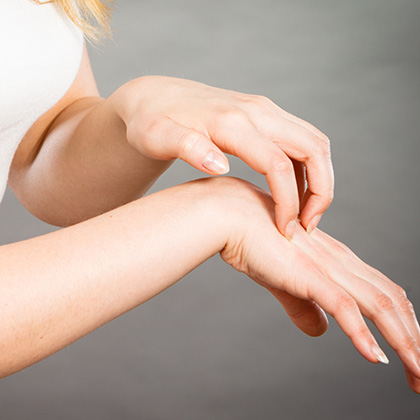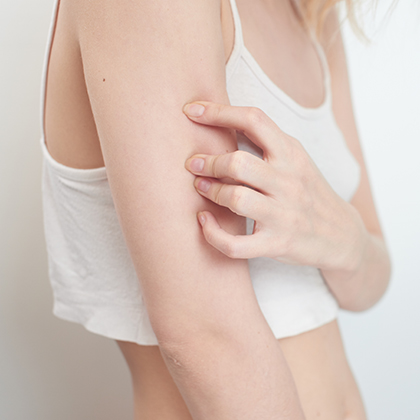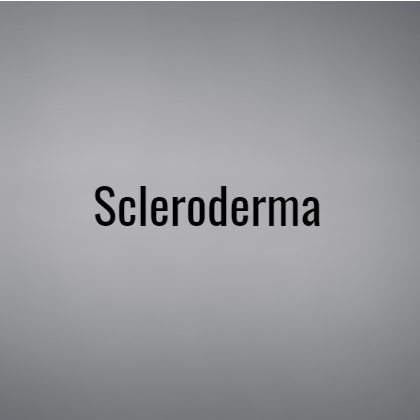
It may not be life threatening or significantly harmful to your health, but hyperhidrosis – or excessive sweating – can be extremely embarrassing and difficult to live with. If you experience persistent heavy perspiration, it can have a major effect on your work, your relationships and your social life, even to the extent that you may avoid social situations altogether – all of which can have a serious impact on your self-esteem as well as other aspects of your mental wellbeing.
Indeed, according to the National Institute for Health and Care Excellence (NICE), hyperhidrosis can have several possible complications, including reduced quality of life, anxiety and depression (i). Meanwhile NICE adds there can be physical complications of hyperhidrosis too, including:
-
Bromhidrosis (unpleasant body odour)
-
Skin maceration (damage to the skin caused by excessive exposure to moisture)
-
Bacterial and fungal skin infections
-
Pitted keratolysis (a bacterial skin infection that can affect the soles of the feet and the palms of the hands)
Why do we sweat?
Hyperhidrosis is described by the health charity Hyperhidrosis UK as ‘excessive sweating beyond what is required for physiological temperature regulation’ (ii). The most common sweat glands in your body (eccrine glands) produce sweat when your body temperature rises – during hot weather, for instance, or while you’re exercising. A colourless liquid made mainly of water with some salts, sweat helps cool you down when it evaporates on the surface of your skin.
Other glands called apocrine glands also produce sweat: these make up about a quarter of all your sweat glands and are found mostly in areas where there are lots of hair follicles (armpits and groin, for instance). Apocrine glands are thought to produce sweat as a response to stress, anxiety and nervousness, and may be triggered by hormones rather than the nervous system (iii). Either way, the sweat your body produces doesn’t have any smell – until, that is, it comes into contact with bacteria that live on your skin.
How common is hyperhidrosis?
We don’t really know exactly how many of us have hyperhidrosis since experts believe there could be a significant number of people who don’t seek any medical help for it. Worldwide around one per cent of people are estimated to have hyperhidrosis, with Japanese people thought to be affected more than other populations. Men and women are thought to be affected equally, though women are more likely to talk to their GPs about it (iv).
But how do you decide if how much you’re sweating is too much? While hyperhidrosis is indeed a recognised medical condition, there are no guidelines that state how much sweat you have to produce to be officially diagnosed with it. That may be because it’s difficult to put a figure on such a thing, since sweating varies so much from one person to another – you could, for instance, lose less than a litre of water or several litres a day through perspiration, depending on how active you are and how hot the weather is.
The thing that really matters is how much your sweating affects your quality of life. If, for instance, you perspire to such an extent that it affects how you live, then you’re said to have a sweating problem.
Hyperhidrosis causes
Some cases of hyperhidrosis have a known medical cause – read on to find out more about secondary hyperhidrosis. But experts don’t really know what causes the majority of cases. However according to Hyperhidrosis UK, some believe it has something to do with overactivity in the sympathetic nervous system (v) – that is, the network of nerves that activates the so-called fight-or-flight response when you’re under stress or in danger (effects of the fight-or-flight response include an increased heart rate and breathing rate).
The US-based Primary Care Dermatology Society explains that the thoracic sympathetic ganglion chain of the sympathetic nervous system controls the eccrine and apocrine glands (vi). And when this chain becomes overactive, it causes excessive sweating. However, in the majority of cases of hyperhidrosis it isn’t clear why this chain becomes overactive in the first place.
Hyperhidrosis has no official cure, but the good news is that there are excessive sweating treatments you can try that are often effective.
Types of hyperhidrosis
The main type of hyperhidrosis is called primary focal hyperhidrosis. This most often starts in childhood – sometimes even as early as at birth – and in young people aged 25 or younger (though it can develop at any age). According to Patient UK, primary focal hyperhidrosis affects around three in every 100 people (vii).
Primary focal hyperhidrosis isn’t connected with any other medical conditions. Indeed, nobody really knows what causes it. However, it can run in families, which suggests there may be some genetic factor involved in its development (according to Hyperhidrosis UK as many as 50 per cent of people with primary focal hyperhidrosis have a positive family history of the condition (ii)).
If you have primary focal hyperhidrosis your symptoms can come and go, or you may experience times when you sweat more profusely than usual. Primary focal hyperhidrosis can also be aggravated by things like stress, anxiety, hot weather, exercise and eating spicy foods. However, you won’t usually sweat excessively while you’re asleep, and for most people the symptoms tend to improve as they get older.
Meanwhile primary focal hyperhidrosis affects various areas of the body, often several at the same time and usually both sides at the same time, including:
-
Underarms (axillary hyperhidrosis): this tends to be more common in women than men (ii)
-
Feet (plantar hyperhidrosis): this may be a common problem because there’s a larger concentration of sweat glands in your feet than anywhere else in your body (viii)
-
Face (facial hyperhidrosis) or face and head (craniofacial hyperhidrosis): this is more common in men than women (ii)
-
Hands (palmar hyperhidrosis): if you are affected by this you may also have a problem with excessively sweaty feet
The other main forms of hyperhidrosis include the following:
Secondary focal hyperhidrosis Experts claim secondary focal hyperhidrosis affects around seven per cent of all people with hyperhidrosis, plus it causes excessive sweating in a particular part or parts of the body (vii). It’s caused by a range of health conditions and can also be a side effect of many medications. Some of the causes of secondary hyperhidrosis include:
-
Infections including HIV
-
Obesity
-
Spinal tumours and spinal cord injuries
-
Sleep disorders such as sleep apnoea and restless legs syndrome (this is also called nocturnal hyperhidrosis)
Medications that can cause secondary hyperhidrosis include some antidepressants, anticholinesterases (medicines used to treat Alzheimer’s disease), pilocarpine (used to treat glaucoma) and propranolol (used to treat high blood pressure).
Like primary hyperhidrosis, secondary hyperhidrosis affects certain areas of the body. But
unlike primary hyperhidrosis, it can make you sweat while you’re asleep.
Generalised hyperhidrosis Less common than primary focal hyperhidrosis, this type of hyperhidrosis affects your entire body. It is usually caused by an underlying medical condition (see above for examples).
Meanwhile another type of hyperhidrosis – called gustatory hyperhidrosis – causes excessive sweating of the head, neck and sometimes also the chest. This is triggered by eating certain types of food, though smelling food, or even thinking about it can bring on symptoms in some people too. Frey’s syndrome, meanwhile, can cause sweating in those who have had an operation called a parotidectomy (this is the partial or complete removal of the parotid gland, the largest of the salivary glands).
Should you see your GP?
Since secondary hyperhidrosis can be a symptom of a potentially serious underlying medical condition it’s always a good idea to see your GP if you’re sweating more than you think is normal and you haven’t been diagnosed with any other condition. According to the NHS, you should also make a point of seeing your doctor if (ix):
-
You’ve tried self-help measures for excessive sweating but they’re not working (read on to find out more about how you can help yourself)
-
You’ve been having the problem of excessive sweating for at least six months
-
Your sweating is stopping you from getting on with your daily life
-
You experience excessive sweating at least once a week
-
You sweat a lot at night
-
You have a family history of excessive sweating
-
You’re taking a prescription medicine for an existing condition
Hyperhidrosis treatments
As you may have guessed, using a strong antiperspirant is the first thing you may be advised to try if you have hyperhidrosis (avoid deodorants as these only combat odours and don’t help reduce sweating). There are lots of antiperspirants you can buy at pharmacies – look for ones that contain aluminium chloride or aluminium chloride hexahydrate, as these will be stronger than others and can be applied to all skin areas. If these aren’t strong enough, your GP can prescribe even stronger antiperspirants – though these can irritate some areas of your skin that are more sensitive than others.
According to Hyperhidrosis UK, for best results you should apply aluminium-containing antiperspirants to clean, dry skin at night (ii). Your doctor can give you specific instructions on how to use prescription antiperspirants if you need them. If you experience irritation while using antiperspirants, try applying an emollient moisturiser after using the antiperspirant and avoid washing the area with soap (try a soap-free emollient wash instead). You could also try a short course of hydrocortisone cream (a mild steroid cream) on the affected area twice a day for no more than two weeks to help reduce any inflammation.
Other treatments your doctor may recommend include:
Iontophoresis Used to treat hyperhidrosis of the palms, soles and underarms, this uses a low-voltage electrical current passed through tap water. Experts don’t know exactly why this is helpful, but some think it may help block sweat glands (vii). You will usually need several treatments a week for up to four weeks, then less frequent sessions to keep your symptoms under control (you can even buy iontophoresis systems that you can use yourself at home). Hyperhidrosis UK says this can be one of the most effective, safe and non-invasive methods to reduce sweating (ii).
There is also a newer treatment that uses microwave technology to destroy sweat glands in specific areas called miraDry – though at the moment this isn’t usually available as an NHS treatment (it is, however, available privately).
Botox Probably best known for reducing wrinkles by temporarily preventing the movement of facial muscles, Botox injections are also very effective at treating excessive sweating – it’s thought the injections work by blocking the action of nerves that trigger sweat gland activation. Botox treatment is most often used to treat underarm sweating, with each treatment lasting up for around four to 12 months. However, it isn’t always available on the NHS (though you can pay for private Botox treatment).
Medication There are some medicines that stop you sweating excessively – these are often used for people who have generalised hyperhidrosis rather than those who sweat in certain areas. The downside of these drugs, however, is that they often come with potential side effects such as dry mouth, constipation and urination difficulties.
Surgery Having an operation for hyperhidrosis is usually only recommended for people who have tried other treatments without success or if other treatments are causing intolerable side effects, as complications can sometimes develop after you have surgery. Hyperhidrosis surgical procedures include removing sweat glands or interrupting the nerves that activate the sweat glands, and typically aim to help reduce facial, underarm and palm sweating (surgery isn’t usually carried out for hyperhidrosis of the feet).
What can you do to help yourself?
Thankfully there are also several things you can do yourself if you’re affected by hyperhidrosis that may help make you feel more comfortable. Some of the general self-care advice for excessive sweating includes the following:
-
Avoid eating hot and spicy foods if they make you sweat more. Also try to figure out if there are any other foods that trigger sweating and avoid these too – for some people these triggers can include alcohol and caffeine.
-
Avoid wearing clothes made from man-made fabrics – stick to breathable fabrics such as cotton and linen whenever possible.
-
Try wearing clothes that are loose fitting rather than tight fitting (especially under the arms). Also try using disposable underarm pads in your clothing – these are available at pharmacies – or look for clothes that have special built-in underarm sweat protection.
-
When possible, choose clothes that are either white or black as they are less likely to show sweat marks than clothes in other colours.
-
Avoid wearing boots and shoes made from synthetic materials (including sports shoes) – instead choose ones made from breathable materials such as leather.
-
Try not to wear the same pair of shoes every day: allow each pair a full day to dry out before wearing again.
-
Try putting special insoles in your shoes made with charcoal or bamboo to keep your feet dry as well as socks made with antimicrobial materials such as silver and copper to reduce odours.
-
Change your socks frequently (at least twice a day) and use an absorbent foot powder at each change.
-
If stress and/or anxiety make your symptoms worse, consider taking steps towards managing them more effectively – you can find more advice that may be helpful in our guides to anxiety symptoms and stress symptoms.
If you’re affected by hyperhidrosis, even everyday life can at times be a challenge. Getting the right treatment – whether that’s something you do yourself or something offered by a health professional – can make a big difference, so it’s always worth speaking to your GP about your symptoms. There’s also more to read about generalised hyperhidrosis/sweating in our guide to sweating causes and treatments. For information on a wide range of other health and wellbeing issues, why not take a tour around our pharmacy health library?
References:
-
Available online: https://cks.nice.org.uk/topics/hyperhidrosis/background-information/complications/.
-
Available online: https://hyperhidrosisuk.org/wp-content/uploads/2019/10/hyperhidrosisuk-hcp-leaflet-2019-web.pdf.
-
Anatomy, Skin Sweat Glands by Bonnie D Hodge and Robert T Brodell. Available online: https://www.ncbi.nlm.nih.gov/books/NBK482278/.
-
Available online: https://cks.nice.org.uk/topics/hyperhidrosis/background-information/prevalence/.
-
Available online: https://hyperhidrosisuk.org/affected-areas/.
-
Available online: https://www.pcds.org.uk/clinical-guidance/hyperhidrosis.
-
Available online: https://patient.info/skin-conditions/excessive-sweating-hyperhidrosis.
-
Available online: https://rcpod.org.uk/common-foot-problems/sweaty-feet.
-
Available online: https://www.nhs.uk/conditions/excessive-sweating-hyperhidrosis/
You Might Also Like
Disclaimer: The information presented by Nature's Best is for informational purposes only. It is based on scientific studies (human, animal, or in vitro), clinical experience, or traditional usage as cited in each article. The results reported may not necessarily occur in all individuals. Self-treatment is not recommended for life-threatening conditions that require medical treatment under a doctor's care. For many of the conditions discussed, treatment with prescription or over the counter medication is also available. Consult your doctor, practitioner, and/or pharmacist for any health problem and before using any supplements or before making any changes in prescribed medications.

Christine
Christine Morgan has been a freelance health and wellbeing journalist for almost 20 years, having written for numerous publications including the Daily Mirror, S Magazine, Top Sante, Healthy, Woman & Home, Zest, Allergy, Healthy Times and Pregnancy & Birth; she has also edited several titles such as Women’ Health, Shine’s Real Health & Beauty and All About Health.
View More



